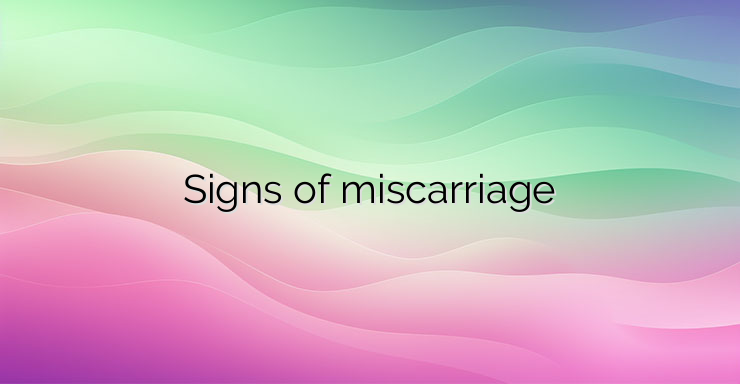A pregnancy that terminates on its own within the first 20 weeks of gestation is referred to as a miscarriage. This is the most common type of pregnancy loss. Studies show that 10 to 25% of all clinically recognized pregnancies end in miscarriage. Chemical pregnancy can account for 50-75% of all miscarriages. This occurs when the pregnancy is lost soon after implantation, resulting in bleeding that occurs around the time of the expected period. A woman may not even realize she is pregnant. What can be warning signs of miscarriage? Bleeding Bleeding may start as a light spotting or it may be heavier and look like a hemorrhage. As the cervix dilates to accommodate the fertilized egg, the bleeding becomes heavier. The heaviest bleeding usually stops within three to five hours of starting. Lighter bleeding may stop and start for one to two weeks before stopping completely. The color of the blood can vary from pink to bright red or brown. Red blood is “fresh blood” that quickly leaves the body. Brown blood is blood that has been in the uterus for a period of time. During a miscarriage, coffee grounds-colored or almost black discharge may be observed. Other symptoms of miscarriage may include: Mild to severe back pain (often worse than normal menstrual cramps); Weight loss; Vaginal discharge with a whitish-pink color; Real contractions (very painful every 5-20 minutes); Separation of tissue with clot-like material; Sudden decrease in pregnancy symptoms. Most miscarriages occur in the first 12 weeks of pregnancy. What is the cause of early miscarriage? During the first trimester, the most common causes of miscarriage are chromosomal abnormalities. Most chromosomal abnormalities are caused by a damaged egg or sperm, or are due to a problem when the zygote has gone through the division process. Chromosomes are small structures inside the cells of the body that carry many genes, the basic units of heredity. The causes of miscarriage are varied and most often cannot be identified. Other causes of miscarriage include (but are not limited to) infection, exposure to environmental and occupational hazards (such as high levels of radiation or toxic agents), hormonal disorders, improper implantation of the fertilized egg in the uterine lining, the age of the the mother, uterine abnormalities, immune system disorders (lupus, autoimmune disease), severe kidney or congenital heart disease, or severe malnutrition. Miscarriage is often a process, not a single event. There are several main types of miscarriage. Threatened miscarriage, which is some degree of uterine bleeding in early pregnancy, accompanied by cramping or pain in the lower back.The cervix remains closed. This bleeding is often the result of implantation. Abortion in progress. It is characterized by pain in the abdomen or lower back, accompanied by bleeding with an open cervix. In this case, miscarriage is inevitable when there is dilation and shortening of the cervix. Complete miscarriage. A complete miscarriage is when the embryo or products of conception have separated from the uterus. Bleeding subsides quickly, as does any pain or cramping. A complete miscarriage can be confirmed by ultrasound or by performing a surgical curettage. Bibliography: americanpregnancy.org


Leave a Reply